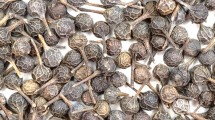Abstract
The stability of tenuazonic acid solution at different temperatures and storage times was studied using methanol, methanol-water (8:2 v/v), benzene and benzene-acetonitrile (98:2 v/v) as solvents. Solutions were analysed by a spectrometric method TeA U.V.-spectrum was recorded. Results indicated that the optimum temperature for long-time storage period of tenuazonic acid solution in any solvent assayed is -20°C. Benzene and benzene-acetonitrile (98:2 v/v) could be advised to make tenuazonic acid solution which will be stored less than 2 months at 4°C. Methanol and methanolwater (8:2 v/v) are not recommended because a low stability of TeA solution in this solvents.
Similar content being viewed by others
References
Dalcero A, Chulze S, Etcheverry M, Farnochi C, Varsavsky E ((1989) Aflatoxins in sunflower seeds: influence ofAlternaria alternata on aflatoxin production byAspergillus parasiticus. Mycopath 108: 31–35.
Torres A, Chulze S, Varsavsky E, Rodriguez M ((1993)Alternaria metabolites in sunflower seeds. Incidence and effect of pesticides in their production. Mycopath 121: 17–20.
Chulze S, Torres A, Dalcero A, Etcheverry M, Ramirez M, Farnochi C (1995)Alternaria mycotoxins in sunflower seeds: incidence and distribution of the toxins in oil and meal. Food Protection 58: 1133–1135.
Stinson E, Osman D, Heisler E, Siciliano J, Billis D (1981) Mycotoxins production in whole tomatoes, apples, oranges, and lemons. J Agric Food Chem, 29: 790–792.
Logrieco A, Bottalico A, Visconti A, Vurro M (1988) Natural occurrence ofAlternaria mycotoxins in some plant products. Microb Alim Nutr 6: 13–17.
Robiglio AL, Lopez SE (1995) Mycotoxin production byAlternaria alternata strains isolated from red delicious apples in Argentina. International J Food Microbiol 24: 413–417.
Visconti A, Sibila A (1994) Alternaria Toxins. In: Miller JD, Trenholm HL (Eds.) Mycotoxins in Grain Compounds Other than Aflatoxins, Eagan Press, St. Paul, Minnesota U.S.A., pp. 315–335.
Miller FA, Rightsel WA, Sloan BJ, Ehrlich J, French JC, Bartz QR (1963) Antiviral activity of tenuazonic acid. Nature 200: 1338–1339.
Gitterman CO (1965) Antitumor, cytotoxic, and antibacterial activities of tenuazonic acid and cogeneric tetramic acid. J Med Chem 8: 483–486.
Smith ER, Fredrickson TN, Hadidian Z (1968) Toxic effects of the sodium and the N,N’-dibenzylethylenediamine salts of tenuazonic acid (NSC-525816 and NSC-82260). Cane Chemotherapy Rep 52: 579–585.
Watson DH (1984) An assessment of food contaminants by toxic products of Alternaria. J Food Protection 47: 485–488.
Shigeura HT, Gordon CN (1963) The biological activity of tenuazonic acid. Biochem 2: 1132–1137.
Carrasco L, Vasquez D (1973) Differences in eukaryotic ribosome detected by selective action of an antibiotic. Biochem Biophys Acta 319: 209–215.
Schade JE, King AD (1984) Analysis of the mayor Alternaria toxins. J Food Protection 47: 978–995.
Ciegler A, Lillehoj GB (1968) Mycotoxins. Adv Appl Microbiol 10: 155–219.
Stoloff L, Trager W (1965) Recommended decontamination procedures for aflatoxin. J Assoc Off Anal Chem 48: 681–682.
Scott PM, Kanhere SR (1980) Liquid chromatographic determination of tenuazonic acid in tomato paste. J Assoc Off Anal Chem 63: 612–621.
Montemurro N, Visconti A (1992) Alternaria metabolites, chemical and biological data. In: Chelkowsky J, Visconti A (Eds.) Alternaria, Biology, Plant Diseases and Metabolites, Elsevier, Amsterdam, pp.514–515.
Garcia ME, Blanco JL, Suarez G (1994) Aflatoxin B1 and G, solubility in standard solution and stability during cold storage. Myco Res 10: 97–100.
Beaver RW (1990) Degradation of aflatoxins in common HPLC solvents. J High Res Chrom 13: 833–835.
Wei R, Chu FS (1986) Instability of some trichotecenes in methanol. J Assoc Off Anal Chem 69: 902–903.
Trusal LR (1985) Stability of T-2 mycotoxin in aqueous media. Appl Environm Microbiol 50: 1311–1312.
Visconti A, Doko MB, Bottalico C, Schurer B, Boenke A (1994) Stability of fumonisins (FBI and FB2) in solution. Food Add Contam 11:427–431.
Author information
Authors and Affiliations
Corresponding author
Rights and permissions
About this article
Cite this article
Combina, M., Dalcero, A. & Torres, A. Spectrometric studies on stability of tenuazonic acid (TeA) solution in organic solvents. Mycotox Res 14, 54–59 (1998). https://doi.org/10.1007/BF02945094
Received:
Accepted:
Issue Date:
DOI: https://doi.org/10.1007/BF02945094




